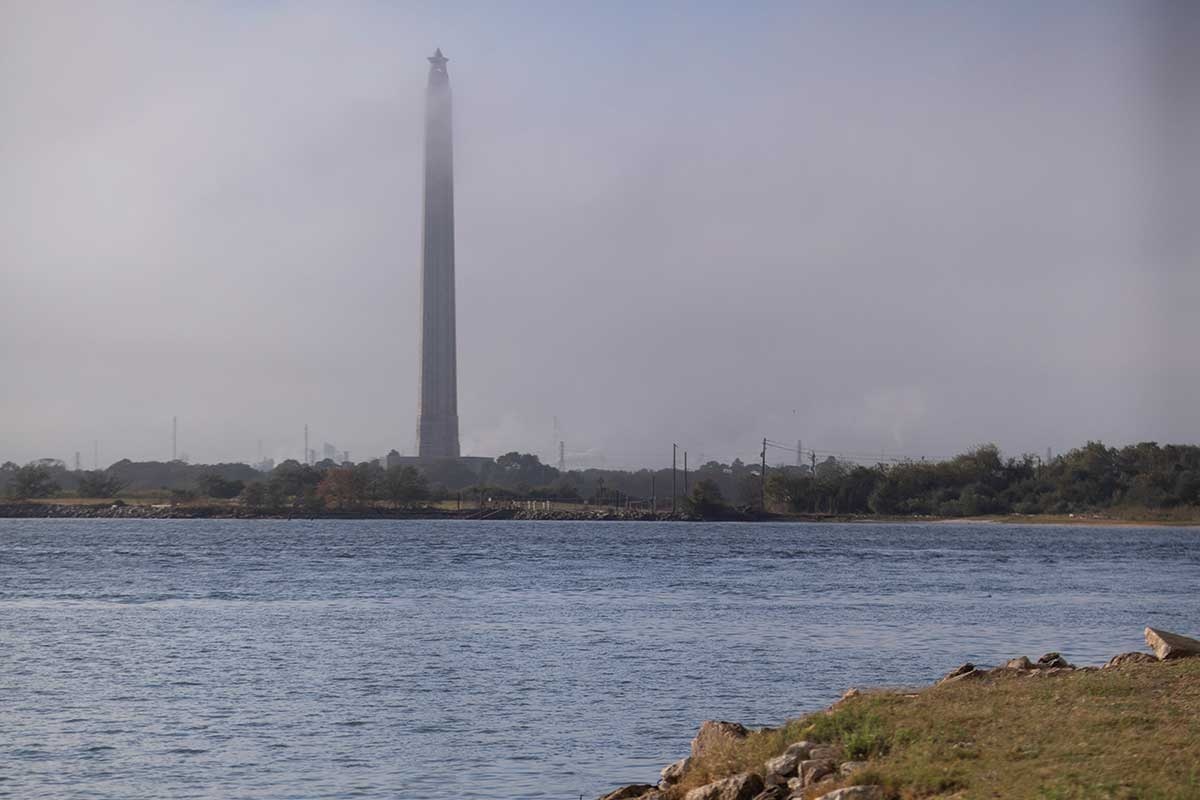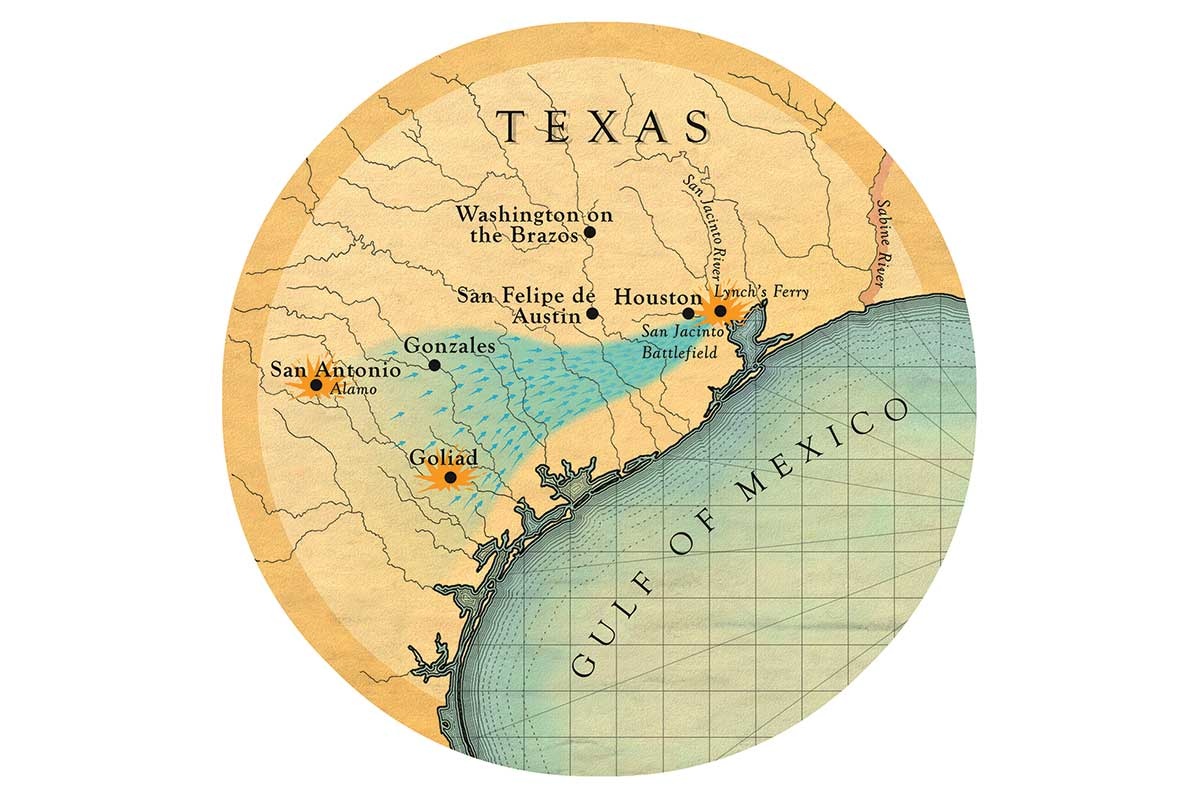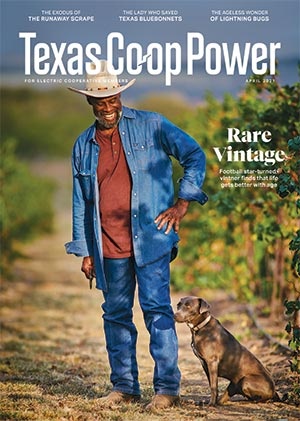The Texas Revolution is defined by its battles—the siege of the Alamo, the massacre at Goliad, the 18-minute Battle of San Jacinto that sealed the Texian victory. But there was a slower struggle that wet spring of 1836 that defined the revolution’s civilian strife. As Gen. Antonio López de Santa Anna amassed troops across the Rio Grande, Texian rebels and noncombatants fled the looming conflict.
This eastward frantic flight from Mexican troops, toward the Sabine River—which separates Texas from Louisiana—and the safety of the United States, came to be known as the Runaway Scrape.
“The Runaway Scrape touched virtually every citizen in Texas,” says Stephen L. Hardin, professor of history at Abilene’s McMurry University, describing the exodus as the great untold story of the Texas Revolution. “I think the Runaway Scrape, far more than the battles, played a major role in the forging of the Texian character.
“It is tremendously important because if you look at the Texas mythos—Texans are tough, Texans are resilient, this notion that we can endure damn near anything because we’re Texans. I think that’s where it starts.”
Colonists began their flight from conflict well ahead of the fall of the Alamo in March 1836, and for some of them, the escape culminated within a mile of the San Jacinto battlefield site in a dramatic crossing of the San Jacinto River. There, 5,000 settlers waited their turn at Lynch’s Ferry, desperate to outrun Santa Anna and his approaching troops.
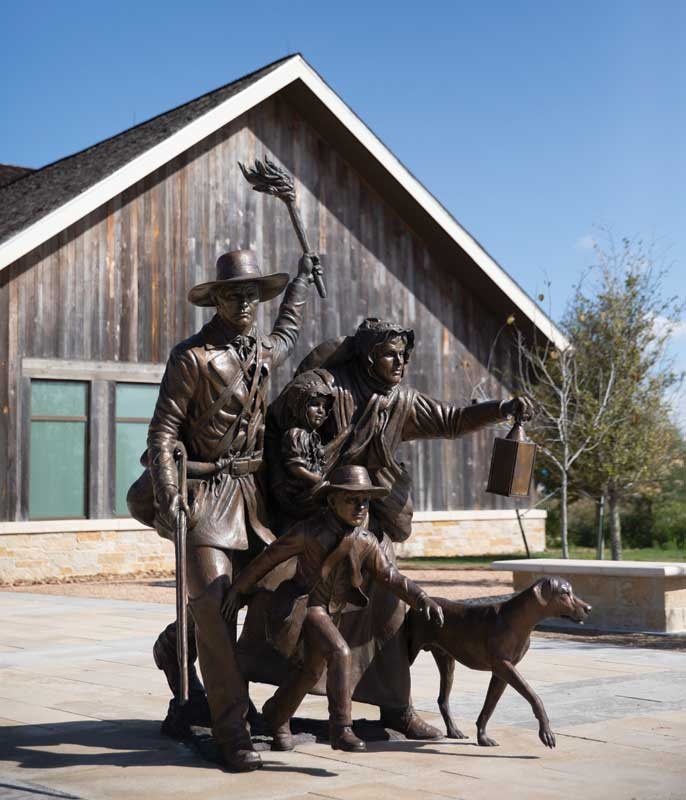
A sculpture by J. Payne Lara at the San Felipe de Austin State Historic Site depicts a family fleeing in the Runaway Scrape.
Julia Robinson
About the time of the fall of the Alamo, Hardin says, the Runaway Scrape “goes into hyperdrive.” Sam Houston and his small, inexperienced army began a retreat from Gonzales, where the army had been gathering. The order to evacuate came at midnight March 13, and the Texians burned the town before they left.
As Houston continued his retreat, many of the 30,000 residents of Texas—including Anglos, enslaved people and Mexican nationals—fled Santa Anna’s army in the rain and cold, carrying what possessions they could on muddy roads and across flood-swollen rivers. In an April 1836 letter to a friend, colonist John A. Quitman remarked, “We must have met at least 1,000 women and children, and everywhere along the road were wagons, furniture and provisions abandoned.”
Dilue Rose Harris was 11 when she fled her home in Stafford’s Point, just southwest of what is today Houston, with her family. In 1898 she wrote of her memories of the Runaway Scrape: “We left home at sunset. Hauld beding clothing and provision on the sleigh with one yoak of oxin. Mother and I walking she with an infant in her arms.”
Guy Bryan, a nephew of Stephen F. Austin, was 16 when he fled his home near San Felipe de Austin with his family. He told his story in an 1895 letter to Kate Terrell, a survivor of the Runaway Scrape and writer who chronicled the event. “Some families left their home with their table spread for the daily meal; all hastily prepared for flight as if the enemy were at their door,” he wrote.
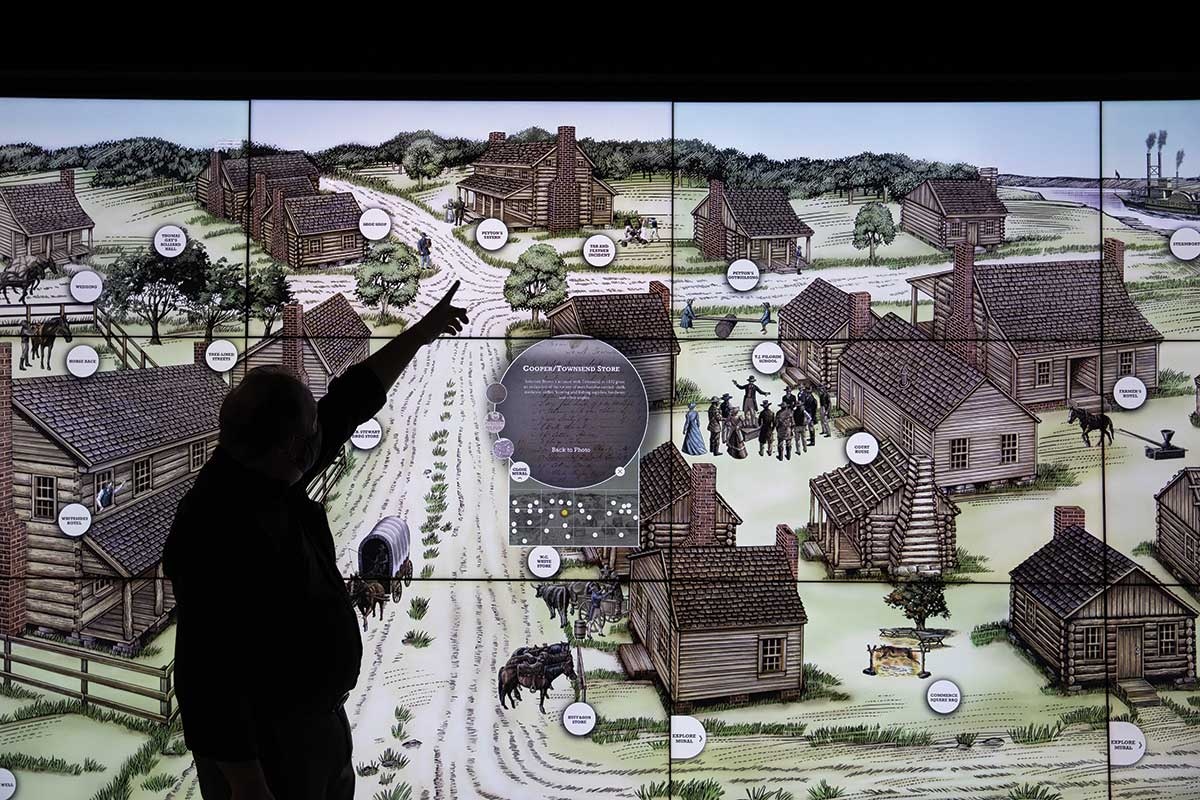
The historic site’s museum features an interactive map of the 19th-century town.
Julia Robinson
The second-largest city in Texas on the eve of the revolution, San Felipe had close to 600 residents and was a bustling center of government and commerce. As in the town of Gonzales, the Texians and their army burned the town behind them, a strategy to deny Santa Anna’s troops food and supplies.
Angelina Peyton Eberly, a tavern owner, recalled in a letter to a friend the evening she evacuated San Felipe across the Brazos River: “Much was left on the river banks. There were no wagons hardly … few horses, many had to go on foot the mud up to their knees—women and children pell mell.” Safely across the river, Eberly could hear “the popping of spirits, powder &c [etc.] in our burning homes.”
Creed Taylor, a Texian soldier who escorted his family to safety before fighting in the Battle of San Jacinto, wrote in 1900, “I have never witnessed such scenes of distress and human suffering. … Delicate women trudged alongside their park horses, carts, or sleds from day to day until their shoes were literally worn out, then continued the journey with bare feet, lacerated and bleeding at almost every step. Their clothes were scant, and with no means of shelter from frequent rains and bitter winds, they traveled on through the long days in wet and bedraggled apparel, finding even at night little relief from their suffering since the wet earth and angry sky offered no relief. … Thus these half-clad, mud-besmeared fugitives, looking like veritable savages, trudged along.”
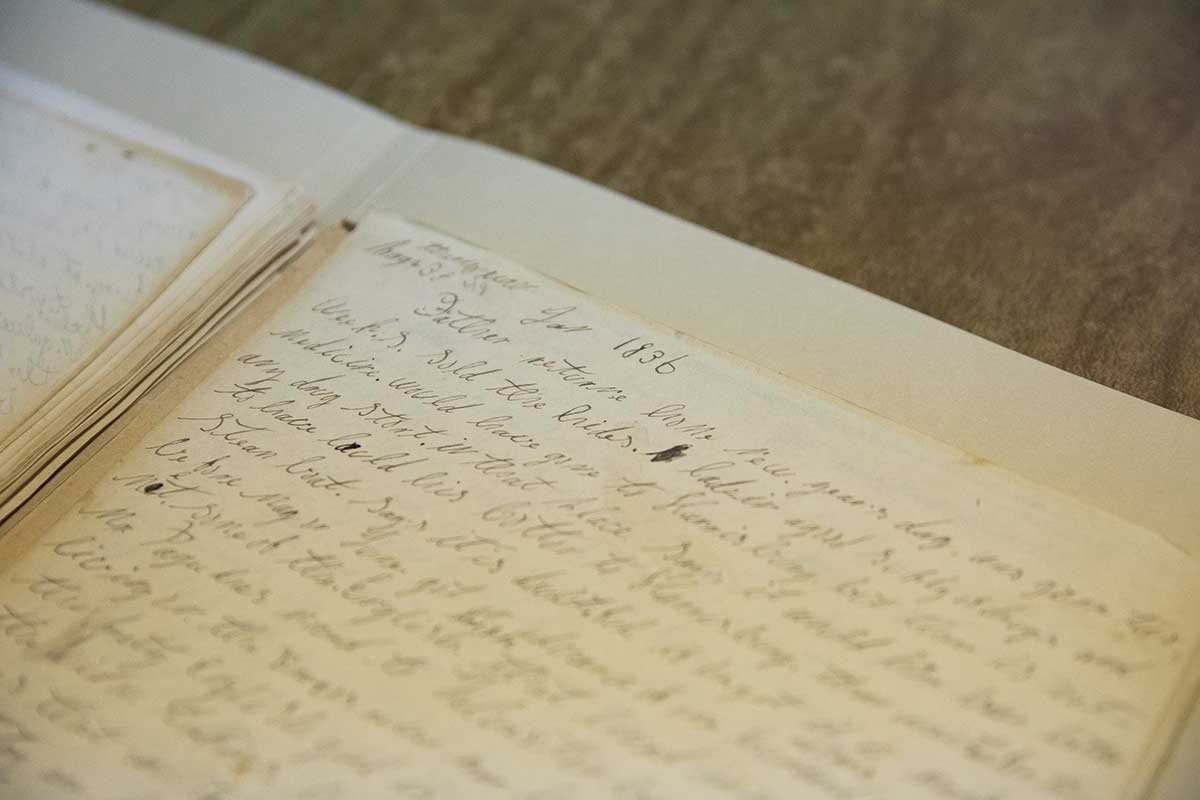
Dilue Rose Harris’ memoirs are at the Albert and Ethel Herzstein Library in the San Jacinto Museum of History in La Porte.
Julia Robinson
Harris, Bryan and Eberly converged with other refugees at Lynch’s Ferry, on the south bank of the San Jacinto River, within a mile of the future battlefield at San Jacinto. “Arrived at the San Jacinto River in the night,” wrote Harris. “There were fully 5,000 people at the ferry. … We waited three days before we crossed. … It was all-most a riot to see who should cross first.”
The crossing was daunting. The ferry was a wooden, flat-bottomed raft, hand-drawn along cables. A few dozen people and possessions could travel per trip.
After crossing the ferry at Lynchburg, Bryan and his party moved 6 miles southeast. “When we joined the long line of ‘Runaways’ at Cedar Bayou the sight was most piteous. I shall never forget the sight of men, women and children walking, riding on horseback, in carts, sleds, wagons and every kind of transportation known to Texas.”
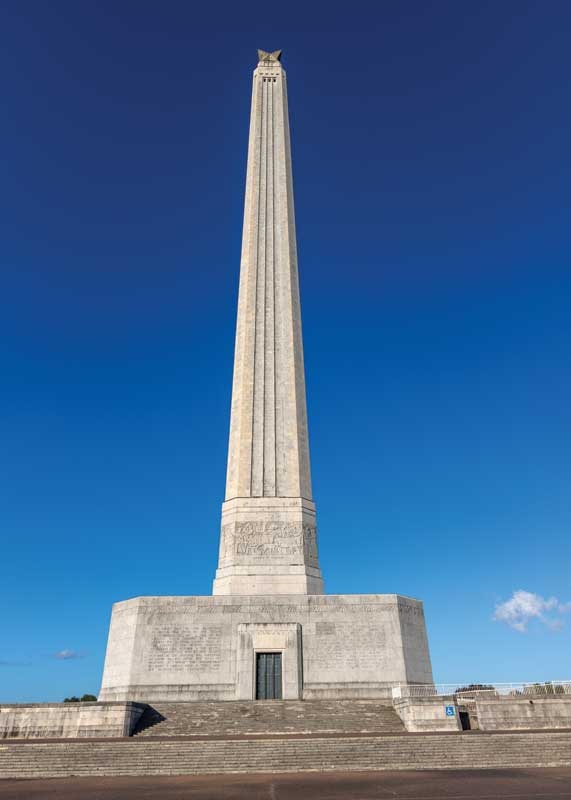
Many families in the Runaway Scrape passed through what is now the San Jacinto Battleground State Historic Site.
Julia Robinson
Many became ill or died along the route. There are no official records of deaths, but historians estimate hundreds died. “Measles, sore eyes, whopping cough, and every other disease that man, woman or child is heir to, broke out among us,” wrote Harris. Her younger sister died of a flux—diarrhea—and was buried at Liberty. With scant updates, families kept moving east, toward the Sabine River and the safety of the United States.
Harris recalled one evening: “All of asddnt we heard a report like distant thunder. … Father said it was cannon that the Texas army and Mexicans were fighting.” They thought the Texians had lost because the cannon fire ended so quickly. They hurried eastward until a messenger found them and yelled, as Harris wrote, “Turn back, turn back. The Texas army has whipped the Mexicans. No danger, no danger.”
Relieved but exhausted, many halted their exodus. Refugee camps sprang up for families to rest and regroup. “They suffered just as much and sometimes more on the return trip,” Hardin says. Many returned to find their homes burned and their livestock missing.
Harris’ memoirs recall quicksand and a fatal alligator attack when they turned back toward home after five weeks on the run. Eberly had traveled more than 100 miles before hearing of the victory at San Jacinto. Once back in San Felipe, Eberly found her tavern and home in ashes, “the place bare of everything but the ruins of all my things burnt up,” she wrote. Many residents, including Eberly, abandoned San Felipe de Austin, which never regained its former stature. Many left Texas for good after the spring of 1836. For those who stayed, the scrape left a scar.
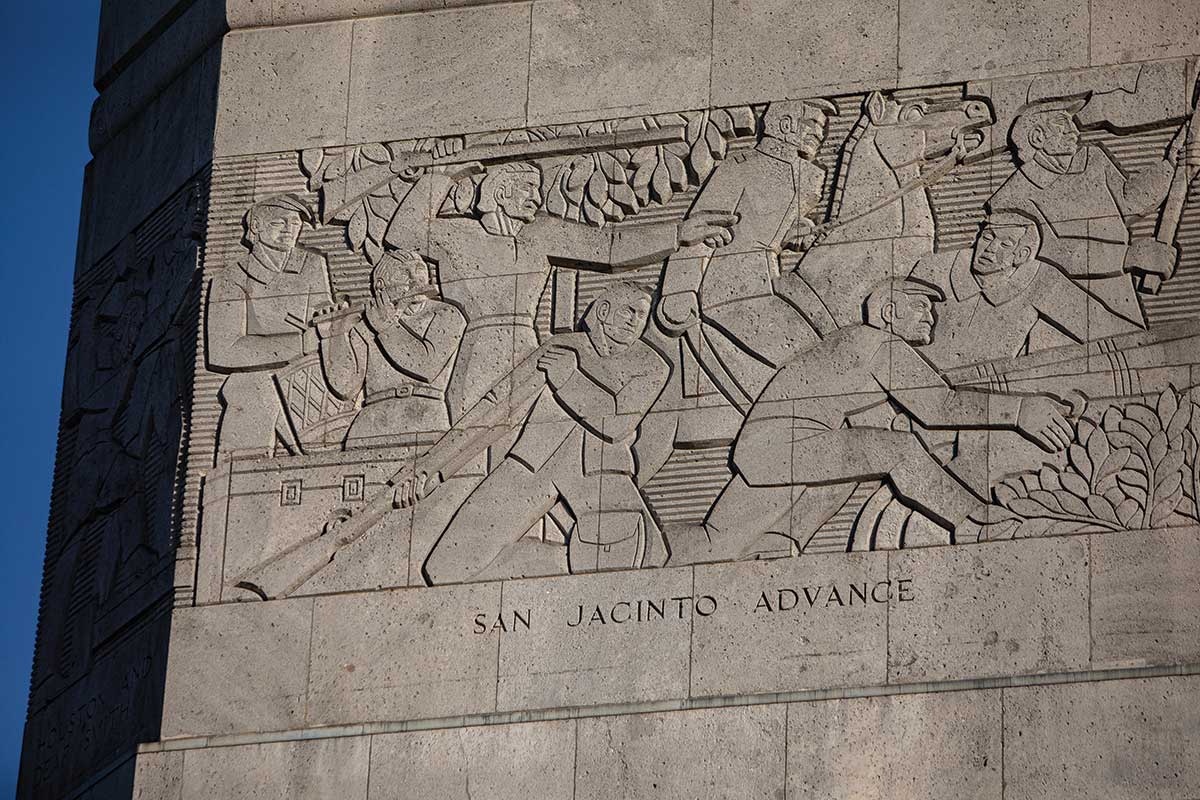
A frieze on the San Jacinto Monument.
Julia Robinson
Hardin explains that many Texians were hesitant to rebuild after the war. “I’ve found many people saying they don’t want to invest in a fancy house because the Mexicans might invade again, and we’re going to have to burn it down again,” he says. “So that plays a huge role in the Texian psyche for years because they just didn’t have the confidence.
“ ‘Remember the Alamo’? What they’re remembering is the Runaway Scrape and the hardship.”
Julia Robinson is a photojournalist in Austin. See more of her work at juliarobinsonphoto.com.
